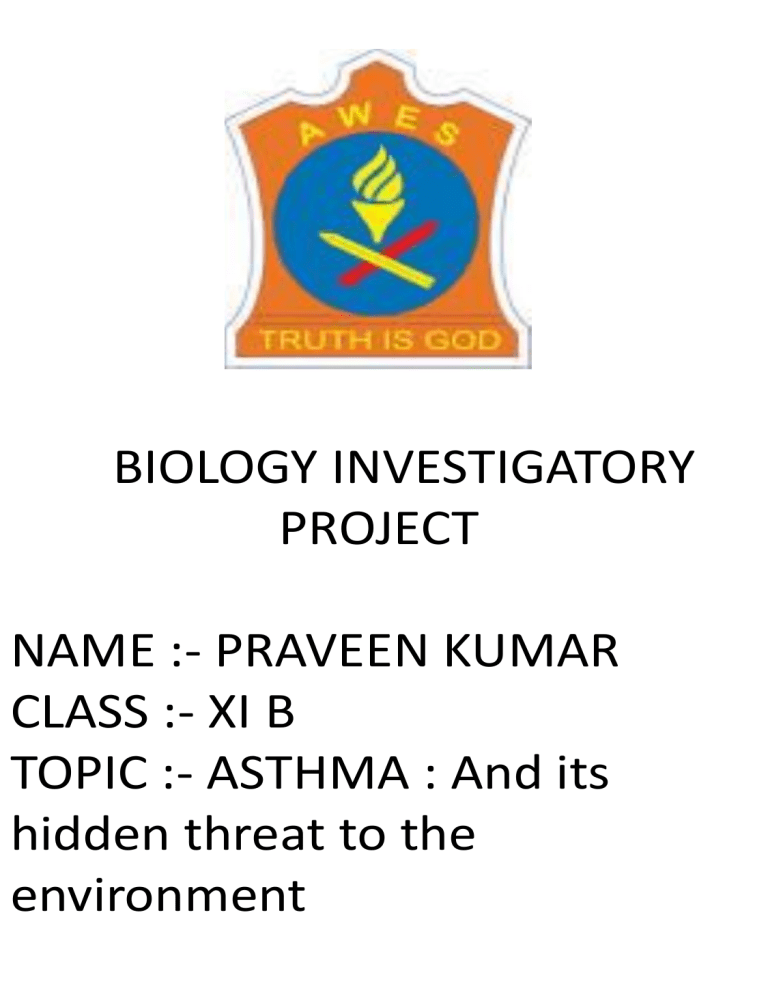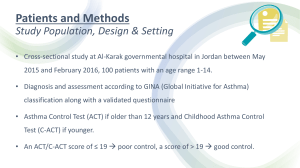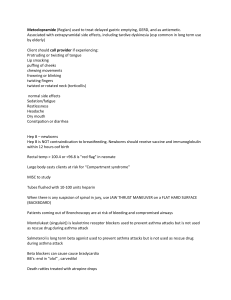
BIOLOGY INVESTIGATORY PROJECT NAME :- PRAVEEN KUMAR CLASS :- XI B TOPIC :- ASTHMA : And its hidden threat to the environment CERTIFICATE This project entitled "ASTHMA: And its hidden threat to the environment" is the investigatory report work in the field of Biology, successfully completed by Mr PRAVEEN KUMAR, student of class XI B, Army Public School, Nehru Road, under the supervision of our biology teacher Mrs. Priya Srivastava, for partial fulfilment of curriculum of Central Board of Secondary Education for year 2022-23. Signature of Teacher Acknowledgement I am are over helmed in all humbleness and gratefulness to acknowledge my depth to all those who have helped me to put these ideas, well above the level of simplicity and into something concrete. I would like to express my special thanks of gratitude to my teacher as well as our principal who gave me the golden opportunity to do this wonderful project on the topic ASTHMA: And its hidden threat to the environment_", which also helped me in doing a lot of Research and I came to know about so many new things. Praveen Kumar INDEX Page no. 1. Overview 05 2. Symptoms 06 3. Undiagnosed asthma 07 4. When to see the Doctor?? 08 5. Causes 09 6. Risk Factors 10 7. Complications 11 8. Why is asthma becoming more 12 common in recent years? 9. How to prevent asthma? 13 10.Conclusion 14 11.Bibliography 15 Overview Asthma attack Asthma is a condition in which your airways narrow and swell and may produce extra mucus. This can make breathing difficult and rigger coughing, a whistling sound (wheezing) when you breathe out and shortness of breath. For some people, asthma is a minor nuisance. For others, it can be a major problem that interferes with daily activities and may lead to a life-threatening asthma attack. asthma can't be cured, but its symptoms can e controlled. Because asthma often changes Over time, it's important that you work with your doctor to track your signs and symptoms Symptoms • Asthma symptoms vary from person to person. You may have infrequent asthma attacks, have symptoms only at certain times - such as when exercising or have symptoms all the time. • Asthma signs and symptoms include: • Shortness of breath Chest tightness or pain • Wheezing when exhaling, which is a common sign of asthma in children Trouble sleeping caused by shortness of breath, coughing or wheezing • Coughing or wheezing attacks that are worsened by a respiratory virus, such as a cold or the flu Signs that your asthma is probably worsening include: • Asthma signs and symptoms that are more frequent and bothersome Increasing difficulty breathing, as measured with a device used to check how well your lungs are working (peak flow meter) • The need to use a quick-relief inhaler more often • For some people, asthma signs and symptoms flare up in certain situations: Exercise-induced asthma, which may be worse when the air is cold and dry • Occupational asthma, triggered by workplace irritants such as chemical fumes, gases or dust • Allergy-induced asthma, triggered by airborne substances, such as pollen, mole spores, cockroach waste, or particles of skin and dried saliva shed by pets UNDIAGNOSED ASTHMA When you think of asthma, what comes to mind? A child using an inhaler? What you may not know is that asthma-a disease that makes it difficult to breathe-can sometimes make its first appearance in adulthood. "Asthma is a chronic lung disease that makes it harder to move air into and out of your lungs," Cheryl Tome, a registered nurse and paediatric asthma coordinator, said. "While asthma often first shows up in children, it can also develop later in life in adults. And it is very common and concerned issue considering its hazardous nature in adults yet being one of the undiagnosed ones" WHEN TO SEE THE DOCTOR?? • Seek emergency treatment. • Severe asthma attacks can be life-threatening. Work with your doctor to determine what to do when your signs and symptoms worsen - and when you need emergency treatment. Signs of an asthma emergency include: Rapid worsening of shortness of breath or wheezing. • No improvement even after using a quick-relief inhaler Shortness of breath when you are doing minimal physical activity. • Contact your doctor • See your doctor • If you think you have asthma. If you have frequent coughing or wheezing that lasts more than a few days or any other signs or symptoms of asthma, see your doctor. Treating asthma early may prevent long-term lung damage and help keep the condition from getting worse over time. • To monitor your asthma after diagnosis. If you know you have asthma, work with your doctor to keep it under. • control. Good long-term control helps you feel better from day to day and can prevent a life-threatening asthma attack. • Don't take more medication than prescribed without consulting your doctor first. Overusing asthma medication can cause side effects and may make your asthma worse. To review your treatment. Asthma often changes over time. Meet with your doctor regularly to discuss your. • symptoms and make any needed treatment adjustments CAUSES • It isn't clear why some people get asthma and others don't, but it's probably due to a combination of environmental and inherited (genetic) factors. • Asthma triggers • Exposure to various irritants and substances that trigger allergies (allergens) can trigger signs and symptoms of asthma. Asthma triggers are different from person to person and can include: Airborne allergens, such as pollen, dust mites, mole spores, pet dander or particles of cockroach • waste • Respiratory infections, such as the common cold • Physical activity • Cold air • Air pollutants and irritants, such as smoke • Strong emotions and stress • Sulphites and preservatives added to some types of foods and beverages, including shrimp, dried fruit, processed potatoes, beer and wine • Gastroesophageal reflux disease (GERD), a condition in which stomach acids back up into your throat Risk factors A number of factors are thought to increase your chances of developing asthma. They include:• Having a blood relative with asthma, such as a parent or sibling. • Having another allergic condition, such as atopic dermatitis - which causes red, itchy skin - or hay fever - which causes a runny nose, congestion and itchy eyes. • Being overweight. • Being a smoker. • Exposure to second-hand smoke. • Exposure to exhaust fumes or other types of pollution. • Exposure to occupational triggers, such as chemicals used in farming, hairdressing and manufacturing. Complications Asthma complications include:• Signs and symptoms that interfere with sleep, work and other activities. • Sick days from work or school during asthma flare-ups. • A permanent narrowing of the tubes that carry air to and from your lungs (bronchial tubes), which affects how well you can breathe. • Emergency room visits and hospitalizations for severe asthma attacks. • Side effects from long-term use of some medications used to stabilize severe asthma. • Proper treatment makes a big difference in preventing both short- term and longterm complications caused by asthma. Why is asthma becoming more common in recent years? • It does seem that more people are being diagnosed with asthma than ever before and that asthma is becoming a more serious disease. It is possible that in recent years we have focused our attention on this disease and that doctors more often are making the diagnosis of asthma, whereas wheezing and cough and shortness of breath may have received other diagnoses in years past. However, many researchers believe that the frequency of new cases of asthma has truly increased. The short answer to the question of why this might be is: we don't know. And many can blame to the environment in which we are living in the past few decades or our lifestyle. How to prevent asthma • Keep away from chemicals and products that have earlier caused breathing problems. • Keep away from allergens s as dust or mould. • Take allergy shots that protect the body against asthmatic triggers. • Take preventive medication, as the doctor prescribes. • Quit smoking and avoid second hand smoke. • Wear a mask when painting, doing construction work or yard work. • Manage stress levels to avoid panic attacks CONCLUSION Asthma is a respiratory syndrome in which the air passage (generally bronchus, bronchioles or trachea) shrink and production of mucus in the passage and lungs increases. It is one of the most common respiratory syndrome in both kids and adults yet undiagnosed among adults. Asthma is an important chronic disease resulting in clinically significant morbidity, missed days of work or school, substantial costs for emergency care and hospitalization, and sometimes, death. If diagnosed at early stages, current therapies can control asthma and may prevent development of irreversible airway changes in asthmatic patients. BIBLIOGRAPHY o NCERT class 11th ❖Internet websites: . . - Mayo Clinic organization Wikipedia Cleve and Clinic organization NCBI WHO




